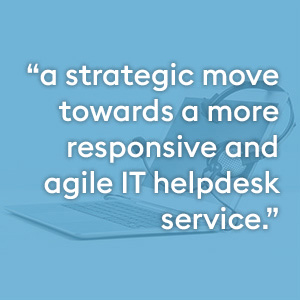The Future of IT Service Desk Operations
Are you keeping up with the competition? Against the backdrop of any competitive marketplace, the agility and dedicated efficiency of your IT Service Desk Operations may well prove to be pivotal to your organisation’s future growth and success. Time and again we’ve seen amazing businesses held back by their technological limitations, but automation – the ability for your IT help desk to do more with less, to streamline processes, yes, but also to enhance service experiences, heighten productivity, increase personalisation, speed up response rates and develop proactive problem-solving strategies – can change everything.
Today, the field of automation is advancing at pace, with new efficiencies transforming the way IT help desks support organisations across the sector spectrum. So, from predictive analytics to intelligent ticket routing and beyond, this article investigates how these innovations will soon be helping IT Service Desks to fluidly adapt and evolve to meet the ever-changing needs and expectations of your users and business like never before.
Automated Ticket Routing
 Imagine a world where every support request is seamlessly channelled to its most efficient resolution path. Automated ticket routing, which has until now utilised systemisation and process streamlining, will already be incorporating rudimentary artificial intelligence (AI) solutions. Advances will soon see AI meticulously analysing every incoming request to determine the best equipped, most readily available team member to direct the ticket to. This change isn’t merely operational – it represents a strategic move towards a more responsive and agile IT helpdesk service, able to dramatically reduce response times and resolve issues more rapidly for everyone’s benefit.
Imagine a world where every support request is seamlessly channelled to its most efficient resolution path. Automated ticket routing, which has until now utilised systemisation and process streamlining, will already be incorporating rudimentary artificial intelligence (AI) solutions. Advances will soon see AI meticulously analysing every incoming request to determine the best equipped, most readily available team member to direct the ticket to. This change isn’t merely operational – it represents a strategic move towards a more responsive and agile IT helpdesk service, able to dramatically reduce response times and resolve issues more rapidly for everyone’s benefit.
Self-Service Portals and Knowledge Bases
User empowerment is set to be an important facet of future IT help desk operations, allowing end users to discover the solution to simple, commonly identified issues for themselves through self-service portals and extensive Q&A knowledge bases. This might seem like a step backwards, but it could be a significant win-win for everyone as it can foster a culture of greater self-reliance and lead to fewer issue instances in future. It can also substantially alleviate the load on IT personnel who can focus on more complex or business-critical demands on their time.
Automated Alerts and Monitoring
Vigilance is a non-negotiable aspect of all effective IT helpdesk services. Some already incorporate automated alerts and monitoring systems, but in the near future these will become even more sophisticated, serving as ever-wary sentinels, watching over your systems, offering real-time insights into their health. Imagine an IT helpdesk that could identify potential issues and respond to them before they can escalate, minimising the possibility of downtime. By enabling IT teams to respond more swiftly and decisively to emerging threats, or ‘anomalies’, the integrity of your organisation’s IT infrastructure is maintained, marking a proactive shift in maintaining any system’s robustness.
Streamlining Operations with Workflow Automation
 The holy grail of technological advancement in the workplace is the eradication of mundane repetitive tasks. If only there was a way of automating them! The reality is that some already are being automated, but in the not-too-distant future repetitive tasks may become a relic of the past, thanks to workflow automation. Automation will ensure that tasks like user onboarding, password resets, and software updates are executed with minimal human intervention, freeing up IT staff to concentrate on strategic initiatives that add substantive business value. The additional benefit of automating these tasks is the removal of human-based errors that could cause frustration, delay and additional costs.
The holy grail of technological advancement in the workplace is the eradication of mundane repetitive tasks. If only there was a way of automating them! The reality is that some already are being automated, but in the not-too-distant future repetitive tasks may become a relic of the past, thanks to workflow automation. Automation will ensure that tasks like user onboarding, password resets, and software updates are executed with minimal human intervention, freeing up IT staff to concentrate on strategic initiatives that add substantive business value. The additional benefit of automating these tasks is the removal of human-based errors that could cause frustration, delay and additional costs.
Predictive Analytics
The ability to anticipate and prepare for future challenges is a hallmark of all efficient and effective IT helpdesk services. Predictive analytics tools are being developed to harness the power of data analysis, and analyse trends and patterns in your company’s use of, and challenges with their IT systems, so IT support teams can better anticipate future potential issues and user needs. This foresight will enable a more strategic allocation of resources and a proactive approach, further cementing the IT Service Desk’s role as a strategic business asset. Imagine the savings possible from a ‘crystal ball’ service – one that is able to use probability to identify future issues and prepare all the resources needed to rapidly respond and swiftly resolve them, organically adapting to the ever-changing needs of your organisation.
Ensuring Compliance Through Automation
As businesses navigate an increasingly complex regulatory landscape, automated compliance checks are set to become a useful feature of future IT Service Desk operations. These systems will continuously monitor and ensure adherence to all relevant regulations and standards, mitigating risks and safeguarding the organisation’s reputation, while allowing your business to focus on its core operations.
Harnessing User Feedback for Continuous Improvement
Any IT Service Desk personnel worth their salt will aspire to be as functionally useful for their client organisations as possible, and this can only happen through the regular gathering of feedback to learn lessons and pivot or improve. Today this may be a largely manual task, but, in the future, automated feedback tools are expected to play an increasingly important role. They can be used to consistently capture user insights and incorporate them within service offerings, driving service enhancements, and fostering a culture of ongoing improvement, to make our helpdesk and IT support services even more user centric.
Conclusion
 The integration of automation within IT Service Desk operations today, and in the future as it rapidly evolves, marks a significant leap towards a more dynamic and user-centric service model. By embracing automated efficiency, businesses can ensure that their IT support is not just responding to issues, but strategically planning for their possibility, driving greater confidence in company technology, innovation, and growth. As we look to the future, the potential for automation to transform IT Service Desk operations is not just promising – it is an imperative for businesses aiming to thrive in competitive markets.
The integration of automation within IT Service Desk operations today, and in the future as it rapidly evolves, marks a significant leap towards a more dynamic and user-centric service model. By embracing automated efficiency, businesses can ensure that their IT support is not just responding to issues, but strategically planning for their possibility, driving greater confidence in company technology, innovation, and growth. As we look to the future, the potential for automation to transform IT Service Desk operations is not just promising – it is an imperative for businesses aiming to thrive in competitive markets.
To summarise, the main benefits of automation in IT Service Desk operations are:
1. Automation can more closely align IT support with your business objectives
2. It can improve system agility to adapt to changing business needs
3. It can transform reactive support into proactive action
4. Automation can turn every helpdesk interaction into a datapoint for uncovering trends and implementing improvements
5. Machine learning algorithms can take this data and predict issues to ensure resources are available when they’re needed
6. Automation can enable IT helpdesks to provide more personalised services
7. It can create more responsive support which leads to greater user productivity (and satisfaction)
8. It can monitor breaches and cybersecurity risks, closing down opportunities for internal and external actors to cause trouble.
We like to think that because we have decades of experience to look back on we can see the future with greater clarity than most. So, at Assembly we know that the journey towards automated efficiency is not just about adopting new technologies, it’s about fostering a culture of agility and continuous improvement through predictable, streamlined and efficient systems that will help us to build stronger, longer-lasting, relationships with our clients.
If you would like to find out more about how far we have incorporated automation into our IT Service Desk operations to date, feel free to get in touch, we’d be happy to share this with you.
Telephone: +44 (0)20 3795 6880
Have you enjoyed this blog? If so, why not share it on your preferred social media platform?






